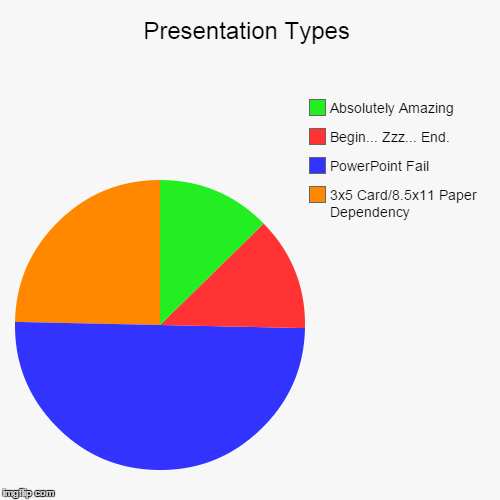As I have witnessed the worse displays of information anyone has ever had to endure (fallacy?), I consider myself an expert on this topic. I have seen over a thousand presentations in my lifetime.

Half have conspired with poor, innocent PowerPoint to commit audio-visual attempted murder. Perhaps a quarter have been without the use of technology. Within the last quarter, half were were so painful, I have wiped them from my memory. I only remember the presenter standing in front of the room, then slow-clapping; everything else is a blur. Of the ones I do remember, however, many had these characteristics:

Half have conspired with poor, innocent PowerPoint to commit audio-visual attempted murder. Perhaps a quarter have been without the use of technology. Within the last quarter, half were were so painful, I have wiped them from my memory. I only remember the presenter standing in front of the room, then slow-clapping; everything else is a blur. Of the ones I do remember, however, many had these characteristics:
- Too much information is on the slide
- The presenter reads from the presentation
- The presenter is playing with something (i.e. a pen, a paper, their pocket lint, etc.)
- The dependence on fillers (i.e. "umm", "you know what I mean", things like that", "like", "basically", "so", etc.)
- The presenter is seemingly trapped behind a podium, desk or table
- No new oral information is added to the information on the presentation
- The presenter never makes eye contact with the audience
- Little to no audience participation is integrated
- Too little (boring/hard to read) or too much (seizure-inducing/hard to read) contrasting of slide colors
The other half of this quarter, a staggering eighth of all presentations, have been spectacular. Most of them have been TED Talks.
TED Talks have been the saving grace for the demonstration of public speaking. They are short, usually experienced-based talks on technology, health, cultural diversity, and global issues. I could go into how incredible the mission of TED is, which is to spread ideas worldwide for free and inspire conversations about the world around us. This is not the goal of every presentation, but what if we, as individuals, set this as a goal to reach for? The aspects of TED Talks which make them entertaining (and thus, memorable) are:
- The presenter is always looking at the audience
- The presenters move: they pace, they use their hands, they smile
- The presenters make the audience laugh
- Usually there are no podiums to hide behind
- Presenters are holding nothing more in their hands than a presentation remote (never a paper or 3x5 cards)
- The shots change every 15 seconds
- The slides presenters use are always one-liners, pictures or videos; usually combinations of these are utilized
I believe three of these characteristics are what make most presentations successful: looking at the audience instead of the material, deliberately moving about the presentation space, and using visual aids. Making a PowerPoint is easy; presenting it is difficult. Presenting involves knowing your stuff. It means practicing the approach you will use to connect with your audience.
I have found that my most successful presentations have involved not only moving around myself, but integrating activities to get viewers moving. I connect with them through using short videos which explain an idea better than I can, usually through demonstrating what cannot be demonstrated within the confines of a classroom. As I stated, one of the aspects of TED Talks which keeps them visually interesting is shot transitions. You cannot make the "scene changes" in the classroom easily, which is why I incorporate the audience into the presentation. If they are moving, their viewpoint changes. I also set my PowerPoints to transition automatically; this way, I do not have anything in my hands to play with. I also know when to move on to a new idea. It paces out my presentation and it looks intuitive.
I do not allow my audience to get bored; I believe they can teach me something as I teach them. I ask them questions. I want them to ask questions, and to comment, throughout the presentation. I also add games (depending on the audience) to my presentations. For example, I will add one small, strange icon throughout the slides which I introduce to the viewers at the beginning. I tell them that whenever they see it, to do whatever the icon is doing. Whoever the first person is gets a piece of candy.
Never underestimate the power of candy. Incentive is a fine reason for doing just about anything; to beg for altruism, even passively, is unrealistic. It sounds strange, but it is a great way for people to stay focused on the presentation instead of falling asleep or playing with their cell phones.
No comments:
Post a Comment